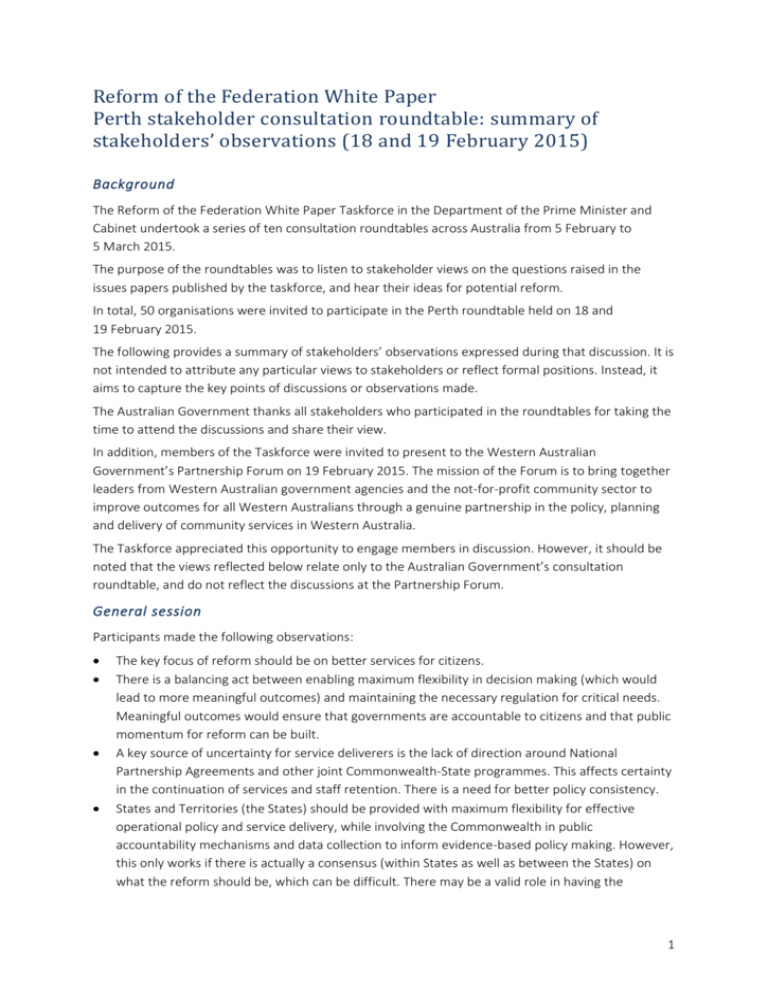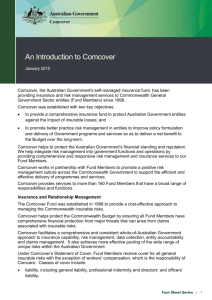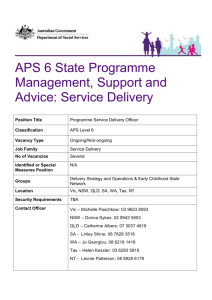Reform of the Federation - Perth stakeholder consultation
advertisement

Reform of the Federation White Paper Perth stakeholder consultation roundtable: summary of stakeholders’ observations (18 and 19 February 2015) Background The Reform of the Federation White Paper Taskforce in the Department of the Prime Minister and Cabinet undertook a series of ten consultation roundtables across Australia from 5 February to 5 March 2015. The purpose of the roundtables was to listen to stakeholder views on the questions raised in the issues papers published by the taskforce, and hear their ideas for potential reform. In total, 50 organisations were invited to participate in the Perth roundtable held on 18 and 19 February 2015. The following provides a summary of stakeholders’ observations expressed during that discussion. It is not intended to attribute any particular views to stakeholders or reflect formal positions. Instead, it aims to capture the key points of discussions or observations made. The Australian Government thanks all stakeholders who participated in the roundtables for taking the time to attend the discussions and share their view. In addition, members of the Taskforce were invited to present to the Western Australian Government’s Partnership Forum on 19 February 2015. The mission of the Forum is to bring together leaders from Western Australian government agencies and the not-for-profit community sector to improve outcomes for all Western Australians through a genuine partnership in the policy, planning and delivery of community services in Western Australia. The Taskforce appreciated this opportunity to engage members in discussion. However, it should be noted that the views reflected below relate only to the Australian Government’s consultation roundtable, and do not reflect the discussions at the Partnership Forum. General session Participants made the following observations: The key focus of reform should be on better services for citizens. There is a balancing act between enabling maximum flexibility in decision making (which would lead to more meaningful outcomes) and maintaining the necessary regulation for critical needs. Meaningful outcomes would ensure that governments are accountable to citizens and that public momentum for reform can be built. A key source of uncertainty for service deliverers is the lack of direction around National Partnership Agreements and other joint Commonwealth-State programmes. This affects certainty in the continuation of services and staff retention. There is a need for better policy consistency. States and Territories (the States) should be provided with maximum flexibility for effective operational policy and service delivery, while involving the Commonwealth in public accountability mechanisms and data collection to inform evidence-based policy making. However, this only works if there is actually a consensus (within States as well as between the States) on what the reform should be, which can be difficult. There may be a valid role in having the 1 Commonwealth assist in getting all the States to the table to agree national standards for performance, priorities and targets. Where the States already have policy plans in certain service delivery areas, the Commonwealth has previously come in with its own ideas as well. The best role for the Commonwealth is to build capacity improvements within the system, as well as promoting best practice rather than duplicating the activities of States. A key question to ask around equity of service is whether we expect exactly the same level of service when we move between States, or if some difference is acceptable. Durability of funding is important, but so is the need for durability of policy direction, so that trust can be built up between service deliverers and governments and that change can be given time to take place. Housing and Homelessness Participants made the following observations: In housing, many of the significant policy levers are in tax and transfers, which is principally up to the Commonwealth. Because of this, consideration of roles and responsibilities in housing is only one set of issues in the sector that need to be considered alongside any changes in the housing market that could flow from changes to tax arrangements. While design and implementation of housing policy would be better at the local level, tax issues are clearly the Commonwealth’s role. It will be important to talk about the tax issues side by side with the expenditure and policy issues in housing. One example of confusion between Commonwealth and State roles was in relation to the National Rental Affordability Scheme (NRAS). On introduction of the NRAS, one participant recalled how their organisation was unsure about which government they should contact about certain issues. Dealing with supply-side issues should overwhelmingly be a State responsibility. The Commonwealth’s role should be holistic direction and guidance, as well as providing incentives to lagging States. The Commonwealth has had a strong leadership role in homelessness, in terms of setting real targets. It is unfortunate that there is ongoing uncertainty in homelessness funding. Converting Commonwealth grants to States for affordable housing to extra Commonwealth Rent Assistance funding would not necessarily be effective, given the rental market reaction to such a move. Greater consideration needs to be given on the supply side, and making sure that planning processes are not a restriction on housing development. Even if the States were wholly responsible for funding and administering social housing, there are still international conventions on social housing entitlements that might require Commonwealth involvement in some way. The WA ‘SharedStart’ initiative, where individuals may obtain a loan from Keystart (the WA government lending agent) to purchase a percentage of a property from the Department of Housing has worked reasonably well. An Australian Housing and Urban Research Institute report into international experience on housing supply bonds and its effectiveness on expanding affordable housing is worth considering. If more policy responsibility and funding for social housing were in the hands of States, there cannot be an automatic assumption that States will treat the most vulnerable citizens the same 2 way. There needs to be some baseline protection for the most vulnerable, as they cannot be the “guinea pigs” for housing reform. Health Participants made the following observations: The main irrationality of the health system is that subsets of the system are predominantly the responsibility of different tiers of government, with primary care the Commonwealth’s responsibility and acute care and infrastructure the States’ responsibility. Increased hurdles for effective service delivery are inevitable as a result. Reform of responsibilities in health is difficult, but necessary to consider nonetheless. Ideally, the Commonwealth should be setting targets and benchmarking standards, but leave service delivery and design to the States. When it comes to setting standards, a national approach shouldn’t necessarily mean involvement by the Commonwealth only, but rather the Commonwealth and the States. In any reform, there is a need to ensure that the focus is on planning around the patient. That should be the goal of any reform to health: empowering patients, and putting the control of care into the hands of consumers. As a result of the split between primary and acute care, it is difficult for GPs to elicit information about a patient’s activity in public hospitals. Timeliness is an issue when GPs elicit such information, and medications can change in the interim. There is a general lack of trust from hospital managers in providing this information to GPs, in case it ‘comes back to bite them’. Disincentives could be removed if roles are realigned. The Ontario Family Health Network system is an interesting example whereby a large part of GP income is no longer linked to volume. GPs are more satisfied in their work and are delivering better outcomes for their patients. This illustrates the benefits of a competitive federalism system whereby innovation and experimentation by sub-national governments is possible. There are examples of programmes in mental health that the Commonwealth set up to ‘coordinate services’. However, it merely made services worse. The Commonwealth’s initiatives added to complexity, rather than reducing complexity through its own programmes. Australians with complex and chronic conditions have the greatest difficulty in navigating the health system. A single funder and purchaser could be the start of a journey towards broader and more coordinated care. However, it is important to use existing bodies and lines of communication (rather than duplicating them). There is also a need to focus on prevention and early intervention into chronic conditions – community providers would be vital in this. Important to any reform is the need to drive innovation. For example, better consultation with individual hospitals could provide further ideas as to how to reduce waiting lists. Some argued that — ideally — a “single-funder” system should be at the centre of a long-term vision for the future of the health system, as this would align financial incentives for better integration of services and care coordination. However, others argued that such a system may work for doctors, but won’t necessarily work for patients. There are issues around mutual recognition in the health workforce. One needs to look at the effectiveness of the National Registration and Accreditation Scheme. In nursing, efforts to have a shared nurse accreditation council and national accreditation of university courses in nursing have increased costs somewhat. However, it has led to a lift in standards and some consistency across the nation, even if there is tension in trying to maintain this consistency. History of mutual 3 recognition shows that there are benefits in national accreditation, and that such schemes are now working well despite initial teething problems. Early Childhood and Schools Participants made the following observations: There is consistently strong evidence that investment in early years to tackle child vulnerability is critical. There is still insufficient attention on early intervention. However, the child and parent integrated centres in WA have been trying to address this need, by establishing collaborative services across different functions (education, health, community protection) that operate differently according to the needs of each area. There is both Commonwealth and WA government funding for these centres. The fact that child and parent centres in WA are like a ‘one stop shop’ with multidisciplinary aspects is important in terms of service delivery. It needs to be coordinated at the State level as there are other services to help vulnerable people that would be a State responsibility. However, given the heavy involvement by both levels of government, it was argued that better clarity would help citizens hold the appropriate level of government responsible for that service. Regardless of where the funding comes from, there needs to be better coordination and longterm initiatives, particularly with Indigenous education programmes. In considering the data collection needs and the Commonwealth’s role in this, there is a need to consider the reporting burden that is already placed on teachers (e.g. in delivering MySchools). There is a need to distinguish between universal and targeted services. Targeted services need to be delivered in the right catchment areas (e.g. research in Canada revealed a substantial number of vulnerable children in mid-range SES areas missed out on services which forced a rethink on where services were delivered). The Commonwealth should have a role when States cannot come together on a significant matter, for the purposes of maintaining equity. One example is students with a disability in early learning centres, with many disabled kids refused childcare because their disability needs could not be catered for. This means that parents are unable to return to workforce. Such situations could justify Commonwealth involvement, in order to ensure an equitable level of service. This may be particularly the case where there are still gaps where States have not fulfilled a mutually agreed minimum standard. The argument for the Commonwealth’s catalyst role in innovation and system building is that it grows capacity, with one such example in literacy and numeracy. While having a national government to observe and spread best practice is important, there is a greater need for diversity in States to allow experimentation. In some instances, a national government role may not even be needed, if the States get together to initiate reform (e.g. as is the case for the education system in Canada). Vocational Education and Training (VET) and Higher Education Participants made the following observations: A key issue is the lack of autonomy that VET providers have. There is a lot of bureaucracy for VET providers that universities can avoid. This affects their ability and agility to provide effective programs. A key part of this is the national standards that the Australian Skills Quality Authority 4 sets, and the variations in these standards between States (in part because some States did not refer their regulatory powers to the Commonwealth). The view of higher education representatives was that VET in schools is inherently problematic because it is difficult for schools to be compliant with the concept of VET. While increased regulation of the VET sector might discourage “rogue” operators, it also discourages universities and legitimate VET providers. Although the differences between jurisdictions in the VET sector is argued by some to be too messy, the advantage of diversity is that it allows States to decide where their workforce needs are and nudge the market in the right direction. The key intersection between the VET and higher education sectors is at the Australian Qualifications Framework (AQF) levels 5 and 6, where you can obtain a diploma and advanced diploma in the VET sector, as well as the higher education sector. Decision making of students here is potentially skewed by the differing financial incentives they face, and what fees they are required to pay up front. The key industry threshold question is whether a qualification is one for work readiness or one for a broader pathway. There is particularly a blurring of lines at AQF levels 5 and 6 , as many VET courses at that level are delivered in a similar way to corresponding university courses. In higher education, changes in reporting arrangements wouldn’t make any difference in practical terms for student outcomes. There was no view that there was a ‘burning platform’ for reform in this regard. One area of open debate about the role of the Commonwealth vis-à-vis the States was in regard to decisions around the location of new university campuses and establishments. The view of higher education representatives was that rather than giving universities the job of implementing the Higher Education Participation and Partnerships Program, the Commonwealth should have worked with the States to implement the programme, focusing on schools. 5






